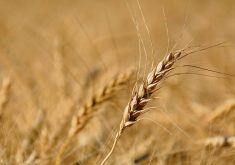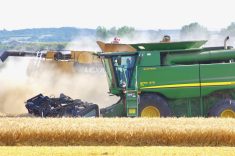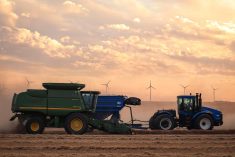MarketsFarm – While a few scattered showers across Saskatchewan delayed some of the harvest, the hot and dry weather has allowed farmers to make more progress than last year.
Seven per cent of the province’s crop has been combined and six per cent is ready to straight combine, according to the Province of Saskatchewan’s weekly crop report for the week ended Aug. 9. The five-year averages were one and two per cent, respectively.
Most of the winter wheat and fall rye crops have been harvested at 54 and 51 per cent, respectively. Peas were 37 per cent finished, while the lentil crop has been 29 per cent combined. Only six per cent or less of all other crops have been completed.
Read Also

U.S. grains: Soy futures post biggest monthly gain in nearly five years on China trade optimism
U.S. soybean futures climbed to a 15-month high and posted their biggest monthly gain in nearly five years on Friday following a rally fueled by the prospect of revived exports to China.
On dry land, the province is estimating one tonne per acre of greenfeed, 0.8 tonnes/acre for alfalfa, 0.7 tonnes/acre for brome, and 0.6 tonnes/acre each for tame hay and wild hay. On irrigated land, the average greenfield yield increases to 2.2 tonnes/acre, two tonnes/acre for tame hay, 1.8 tonnes/acre each for brome and wild hay, and 1.3 tonnes/acre for alfalfa.
Most of Saskatchewan only received small amounts of rain with the Lipton area receiving a province-high 37 millimetres. The rains only provided little change to soil conditions as cropland topsoil was rated as six per cent adequate, 32 per cent short and 62 per cent very short. Hay and pasture land topsoil was rated as five per cent adequate, 28 per cent short and 67 per cent very short.
Heat, wind and drought stress were all responsible for crop damage during the week, as well as flea beetles, grasshoppers and other wildlife.
On Aug. 10, Saskatchewan Agriculture Minister David Marit announced provincial support in AgriRecovery totalling C$119 million, as well as the federal government’s 60 per cent share, increasing funding to C$297 million. Farmers will get a per head payment to maintain breeding stock.













